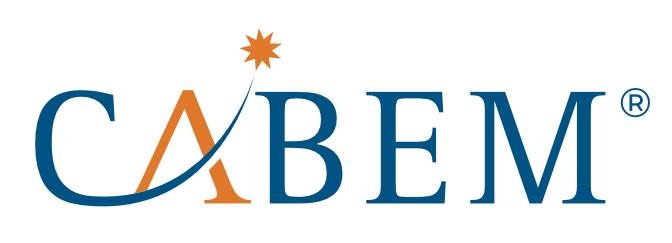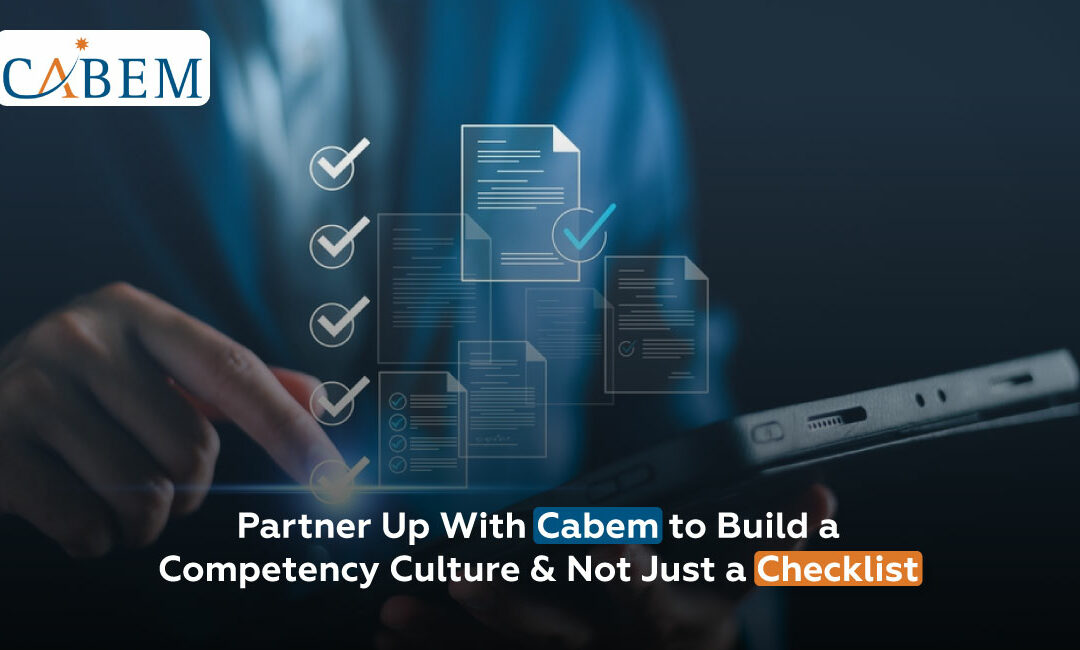Workforce development isn’t about ticking boxes or completing mandatory training—it’s about developing a culture where skills are developed, iteratively improved, and aligned to your business objectives. But, many companies are still stuck in the time and age of training for compliance, meeting government regulation requirements, rather than genuine skill acquisition. At CABEM, we support organizations on their journey beyond tick boxes, working together to bridge their competencies across their strategic ambitions.
Are you aware that 60% of the employees say they do not have the skills required for their job, and over 30% of the companies say that the skills of their employees do not meet the demand of the current work environment (LinkedIn Learning)? This gap is harmful not only for the workforce but also has an impact on organizational growth, efficiency.
In this blog, we will explore why a competency culture is the foundation of organizational success and how CABEM can help develop a competency culture that leads to long-term success. If you want to learn about creating a workforce that thrives instead of just checking compliance boxes, read on.
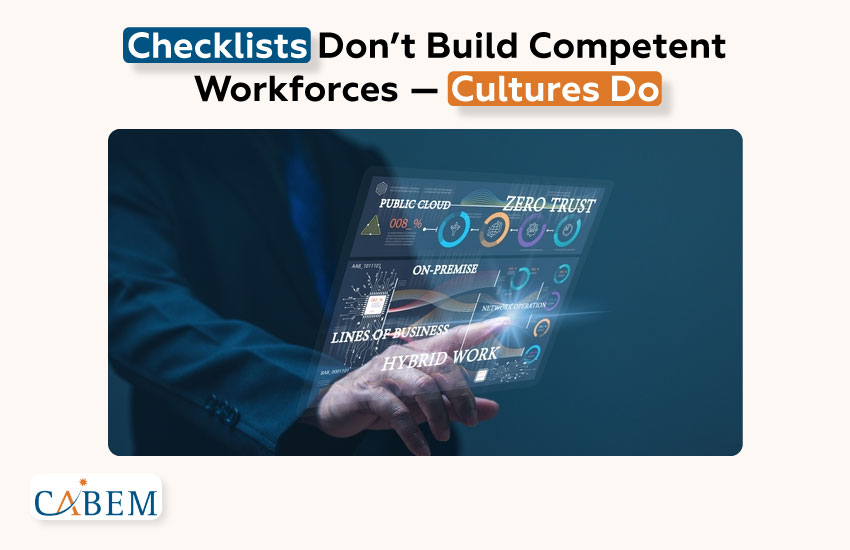
Checklists Don’t Increase Workforce Development — Cultures Do
When a checklist approach is used for competency management, organizations check a box but do not actually make sure the knowledge, skills, and behaviors are learned and applied. While checklists help organizations check off basic training requirements, but fail to develop a strong and resilient workforce.
The Problem With Traditional ‘Checklist’ Approaches
Traditional competency management strategies mainly concentrate on passing audits and don’t encourage genuine skill building. While this has become a common practice, it poses some severe challenges that impede the organization in the long run.
Here are some major problems with the checklist approach, grounded in the real-world data and studies:
- People are marked “trained” with no skills validation:
- Systems don’t adapt to changing roles or regulations
- No support for mentoring, on-the-job evaluation, or recurring verification
- Compliance teams scramble during audits due to gaps:
1. People are marked “trained” with no skills validation:
- An employee might finish a training program, get a certification, but if there are no ongoing assessments or monitoring of performance, it’s unclear if they have mastered the competencies they need to apply on the job.
- According to research from the Association for Talent Development (ATD), 65% of organizations say they do not measure employee learning outcomes well, creating an illusion of competence without measurable results.
- Absence of visible evidence for competency creates inefficiencies in performance and productivity. This usually means that employees are trained in theory but do not have the skills needed to excel at their job.
2. Systems don’t adapt to changing roles or regulations
- With the ever-changing nature of our business environments, where industries, regulations, and standards can change overnight, relying on stagnant training programs or generalised checklists can be suboptimal.
- According to the World Economic Forum, 94% of executives say their employees need to upgrade their skills as new technologies are developed.
- However, a checklist methodology does not have the flexibility required to accommodate an ever-evolving role, responsibilities, or regulatory requirements on the part of an organization. As a part of the industry of innovation and adaptation, businesses dependent on inflexible systems may be unable to meet the evolving skills their workforce needs.
3. No support for mentoring, on-the-job evaluation, or recurring verification
- Developing competencies is a never-ending process; it requires constant feedback and mentoring. However, traditional checklist systems usually do not provide support for continuous learning and coaching or real-time assessment.
- According to Gallup, 59% of employees say they would be more engaged if they received more feedback on their performance.
- Without continuous growth mechanisms enables employees to sustain developmental prospects essential for long-term organizational success. Effective, ongoing guidance, mentoring, and skills verification are essential to building an environment where employees thrive and continually improve.
4. Compliance teams scramble during audits due to gaps:
- Due to fragmented or incomplete competency tracking, compliance audits often cause unnecessary stress for businesses.
- As per a PwC report, a high 72% of organizations admit to facing challenges during compliance audits due to poor tracking systems.
- Without consistent and comprehensive tracking of competencies, preparing for an audit is often the last-minute panic of scrambling through files and records to find everything they need, resulting in the increased risk of non-compliance or missed deadlines. This results in increased pressure on compliance teams, impacting their ability to conduct audits in a robust and effective manner.
Checklist approaches to compliance are detrimental to workforce development, causing organizations to miss out on deeper, more effective compliance opportunities. The solution to this dilemma is the transition to a competency-based culture for real-time tracking and adaptive learning, which can help overcome these challenges for organizational sustainability and success.3
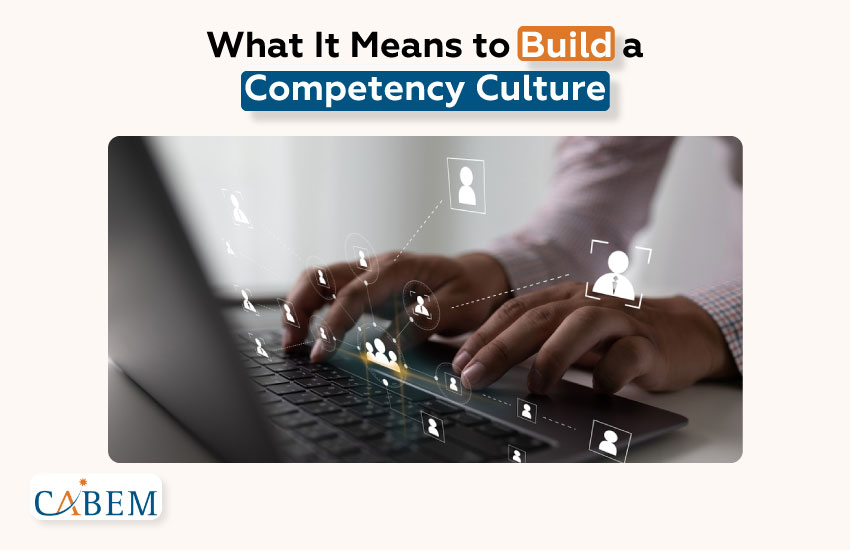
What It Means to Build a Competency Culture
Competency cultures are those that prioritize ongoing skills mastery, regular feedback, and embed competencies throughout the organization. It calls for a change in mindset from compliance to growth, to make people a strategic priority that aligns with the organization’s mission and values.
Such a culture can be defined not only by how you evaluate employees after a particular training session, but rather by creating an atmosphere in which everyone learns more to build better every day.
Define Clear, Role-Specific Capabilities
- A well-defined set of competencies, specific to each role in the organisation, is essential to creating a competency-based culture.
- Employees know the skills and behaviors needed to be successful — this enables managers to identify skills that need to be developed.
- According to a Gallup study, only 50% of workers know what they must do at the job, which results in confusion and underperformance.
- Organizations can ensure that they are aligned with business goals by defining specific competencies. According to the McKinsey report, organizations with defined competencies are 30% more likely to see employee engagement.
Support Continuous Learning, Mentoring, and Skill Verification
- A competency culture thrives on ongoing learning and mentorship.
- LinkedIn Learning study: 94% of employees would stay longer at companies investing in learning and development.
- Mentorship programs and real-time feedback enable employees’ growth.
- Deloitte survey: Companies with strong learning cultures are 92% more likely to develop innovative products and services.
Track Growth Over Time—not Just One-Time Training
- The emphasis should be on continuous growth rather than on single training.
- The World Economic Forum shared that 63% of employees will require substantial reskilling by 2025 due to technological advances.
- With real-time performance data, organizations can adjust their development plans.
- According to Harvard Business Review, continuous development programs result in 11% higher productivity.
Make Competency Everyone’s Responsibility—from the Top Down
- Creating a competency culture takes commitment from all levels of the organisation.
- According to a Bain & Company report, 82% of high-performing organizations include top leadership in competency development.
- Leadership plays a part in setting expectations and building the needed structures for our learning.
- According to the Gallup engagement report, employee engagement is 25% higher where organizations have leadership involvement in employee development.
Fostering Accountability and Adaptability
- A competency culture depends on accountability and adaptation.
- PwC’s Annual Global CEO Survey revealed that key skill availability concerns 71% of CEOs, highlighting the necessity of continuing skill development.
- To be responsive to new challenges, organizations must regularly update their competency models and engage in adaptive learning.
- Organizations fostering accountability achieve 21% higher profitability. (Forbes report)
Building a Holistic Competency Culture
- Developing a competency culture requires a mindset shift that pervades all organizational processes.
- From hiring and training to performance reviews and leadership development, competency has to be cultivated constantly.
- According to a Deloitte survey, competency-based culture leads to 3x better employee performance along with a higher level of engagement and retention.
- Competency-based adaptive culture ensuring innovation, resilience, and competitiveness in a dynamic market.
Establishing a competency culture is a comprehensive effort that needs to be embedded within the organization’s processes, including hiring, training, performance appraisals, and leadership development. It’s a culture that stresses growth, flexibility, and responsibility.
Note: Would you like to know how competency management can change for a classically trained person? In our new blog, “Why Businesses Are Making the Shift to Competency Management vs Traditional Training,” we further explore why organizations are committing to more impactful methods for developing their workforces.
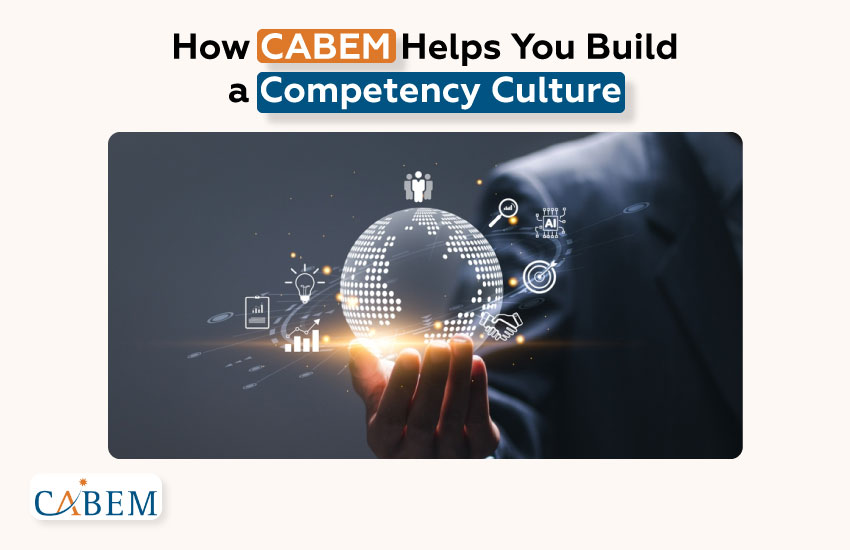
How CAbEM Helps You Build a Competency Culture
At CABEM, we know the value of culture that builds and nurtures competencies over time. Our Competency Manager is here to empower businesses by providing them with the tools and frameworks necessary to nurture continuous learning to keep the employee competencies in line with the needs of the organization.
How CABEM’s Competency Manager Supports a Competency Culture
- Create custom competency frameworks for each role: CABEM’s solution allows you to define competencies particular to each role, so that employees are aligned with the business’s strategic objectives.
- Verify skills through tasks, observations, and peer reviews: Rather than a single session of training, CABEM’s platform validates the competency by measuring skill advancement through real-time assessments, practical tasks, and peer evaluations, making certain workers are, in fact, capable within their function.
- Track real-time gaps and recommend follow-up actions: CABEM’s system monitors employee performance continuously and discovers skill gaps in real-time. It then suggests what can be done to cover the gaps, ensuring that learning is always on track.
- Enable mentors and managers to assess practical performance: With CABEM, mentors and managers can measure employees’ practical performance, give feedback, and provide guidance — this is crucial if employees are to develop world-ready skill sets.
- Automate reassessments and recertification timelines: Competencies are dynamic, not static. CABEM validates certifications and skills in specified times, while automating recertification timelines to ensure employees stay updated with their roles.
- Provide visibility to HR, compliance teams, and leadership: Our system provides complete reporting, which gives HR, regulatory, and management teams complete visibility into employee competencies, easing the process of audits, performance reviews, and compliance checks.
CABEM’s Competency Manager can help organizations create a competency-based culture that evolves with the landscape to help both the individual and organization succeed over time.
Note: Interested in learning some of the basics of competency management? Read our latest blog, “Components of Competency Management – The Big 3,” and learn about the core elements that make workforce development work. Read now, as you will not want to miss insights that will transform your talent strategy!
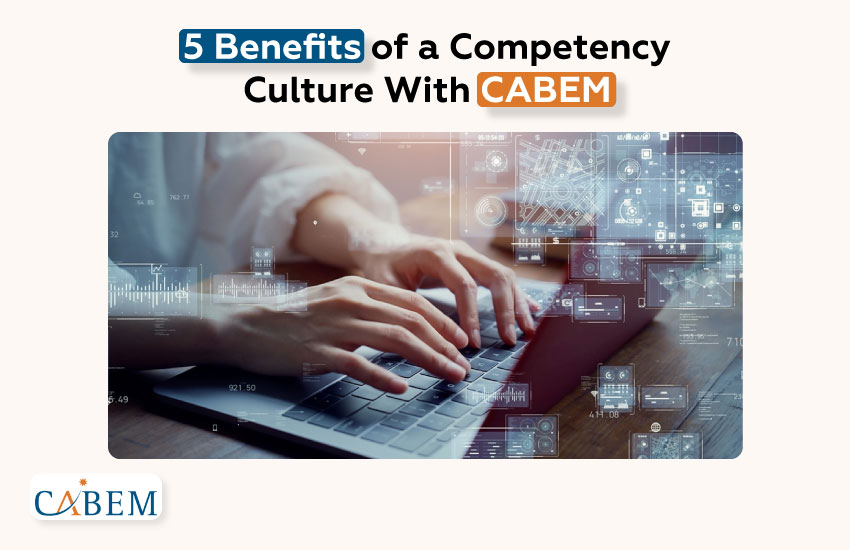
5 Benefits of a Competency Culture With CABEM
The organizations that embrace this competency culture experience many operational and strategic advantages.
Here’s how CABEM’s Competency Manager enables this transformation:
- Increased Workforce Agility
- Reduced Risk & Liability
- Audit Readiness
- Improved Retention
- Lower Training Costs
1. Increased Workforce Agility
Competencies that are developed and sustained by employees that are in alignment with the strategic objectives of the organization will provide more agility to respond to emerging challenges. Being able to enable real-time skills verification allows organizations to pivot quickly in the face of changing markets and demands through continuous learning.
- Agility helps organizations stay competitive in fast-changing industries.
- Employees are able to quickly pivot and take on new roles, or add to existing ones, with minimal retraining required to do so.
2. Reduced Risk & Liability
When organizations embrace a strong competency culture, they mitigate the risks of non-compliance, errors, and accidents. CABEM’s system keeps track of certifications, training, and competencies, making sure that employees have the skills needed to comply with regulations and conduct their jobs safely.
- High-risk industries require a regular verification of the competency of the workforce in order to reduce accident rates.
- Reduces legal and compliance risks with continuous trackers and certifications.
3. Audit Readiness
Such a competency-driven approach leads to stress-free and streamlined compliance and audit processes. CABEM designates reporting, audit, and compliance checks available so the organization is always ready for inspection.
- Saves you those last-minute scrambles during audits.
- Provides automated, audit-ready documentation for compliance teams.
4. Improved Retention
If employees believe their capabilities are being nurtured, they are more likely to stay in an organization. CABEM’s Competency Manager enables personalized development paths that help employees achieve long-term career goals and improve engagement.
- Personalized learning paths lead to greater employee satisfaction and lower turnover.
- Investing in skill-building ensures that your employees will be loyal and want to stay with you for a long time.
5. Lower Training Costs
This focused approach allows organizations to save on the expenses of providing general training on generic topics. CABEM’s system is a resource allocator, ensuring training budgets are spent effectively. Simulation is used to verify the efficiency of each training measure.
- Minimizes waste through relevant and focused training.
- Reduces costs linked to ineffective or duplicative training programs.
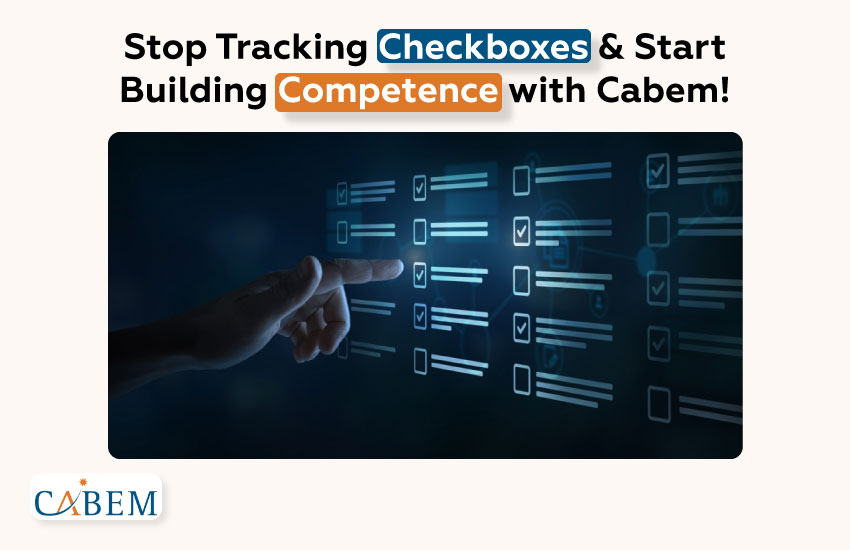
Stop Tracking Checkboxes & Start Building Competence with CABEM!
A competency culture goes beyond being a catchy phrase—it is a critical strategy for achieving lasting growth and operational success as organizations contend with mounting complexity and regulatory pressures, a rapidly evolving landscape and industry dynamics, and an over-reliance on old, checklist/box-ticking approaches will make them fall behind. It is when learning in real time, including skill learning and feedback, becomes ingrained in the fabric of the organization.
Through the implementation of our Competency Manager, organizations ultimately move all the way from convenient compliance to actual transformation. The advantages of a competency-based approach are obvious, from improving workforce adaptability and lowering risk to guaranteeing audit compliance and boosting employee loyalty.
Let us stop the ticking boxes approach and start creating a workforce that’s fit for the future. With CABEM, you ensure compliance and create an environment that empowers employees to grow and adapt, adding to long-term organizational success.
Ready to transform your business? Team up with CABEM to create a culture centered around competency formation that leads the way to performance, growth, and innovation.
Let’s unlock the full potential of your workforce, together.
FAQs
Why is it important for an organization to develop cultural competence?
Cultural competence helps organizations create inclusive contexts, facilitating communication and strengthening connections with diverse communities and contributing to improved performance and customer satisfaction.
What does developing cultural competence mean?
It refers to acquiring the knowledge, skills, and attitudes to communicate effectively and respectfully with individuals from various cultural backgrounds and embedding these practices into organizational frameworks.
How do you create cultural competence?
Cultural competence can be built through training programs, promoting diversity and inclusion, encouraging continuous education, and promoting meaningful intercultural exchanges.
What is an example of a competency gap?
A competency gap typically happens when employees are certified with a skill but do not possess the hands-on experience or practical knowledge to help them perform well and effectively in the workplace, often leading to inefficiencies or errors in the workplace.
